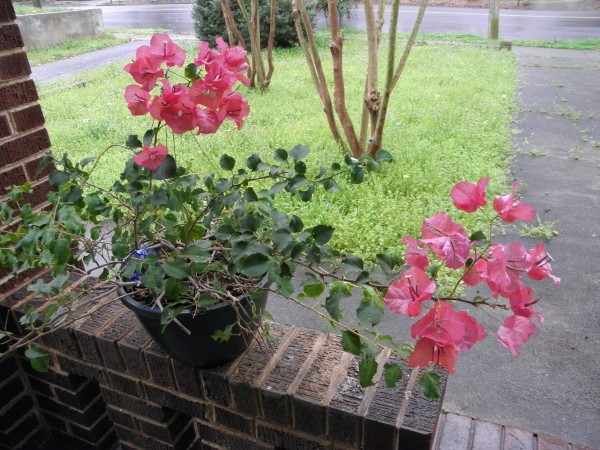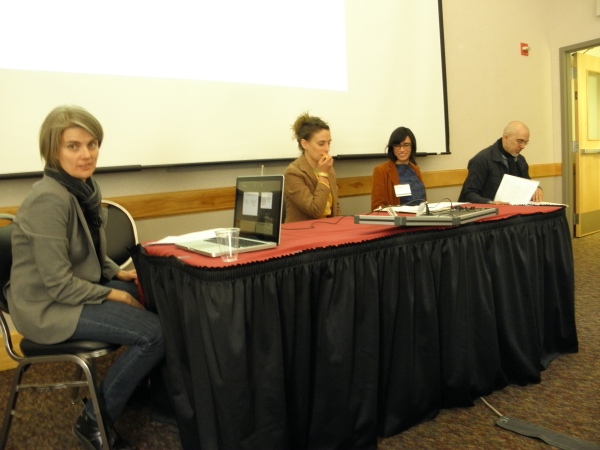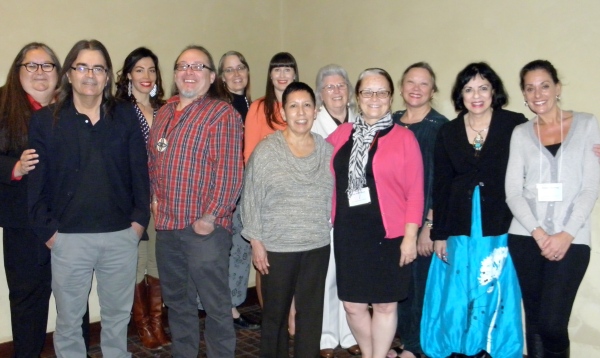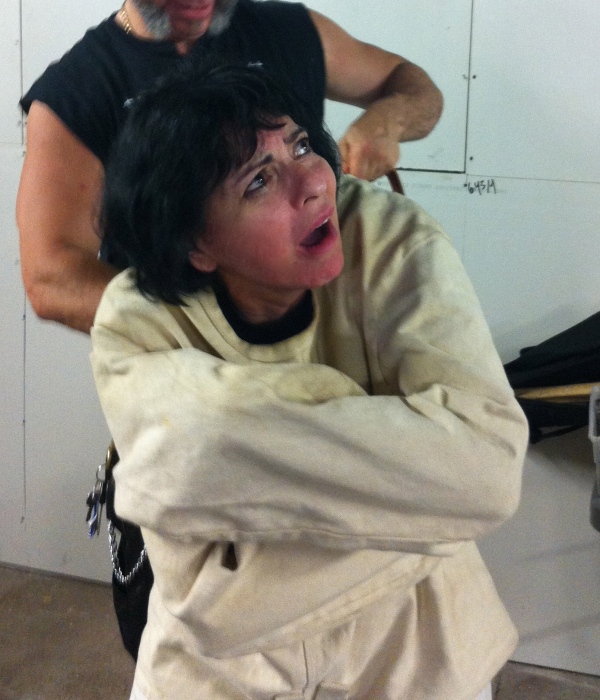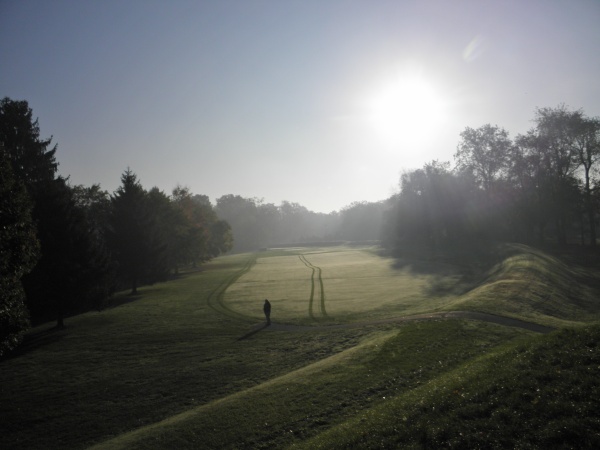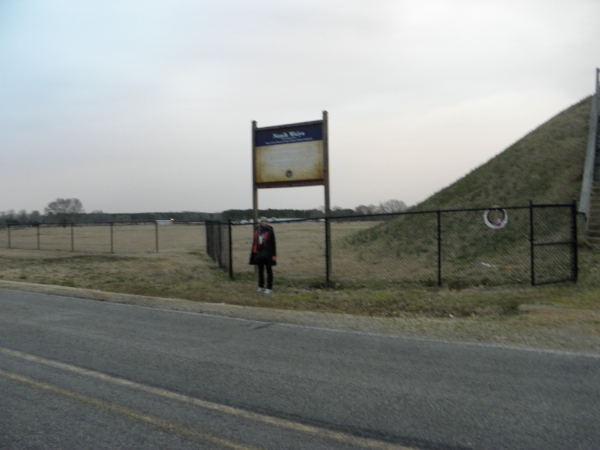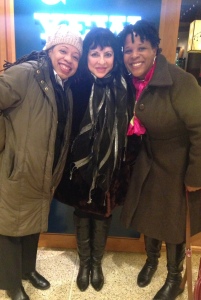Awards, New Books, New Friends
Congratulations Tyehimba Jess for winning the 2017 Pulitzer Prize for Poetry for Olio. I first met Tyehimba in 2005 at the University of Illinois, Urbana-Champaign. That year Illinois hired author Rigoberto Gonzales, (Butterfly Boy, among a dozen more books), Tyehimba Jess (Leadbelly, Oilo) and me (Shell Shaker, Miko Kings: An Indian Baseball Story). This last year I taught Olio in my graduate symposium in English at UGA Athens. What a fascinating read. Rush out and buy it. Read it. Chew on the pages.
Just returned from the NonFictionNow Conference in Reykjavik, Iceland. Below is a powerful waterfall, not from from the capital city. The countryside in Iceland is gorgeous, in some places other worldly, lots of volcanos simmering, waiting to erupt. And the conference had all the rockstars of CNF, myself excluded.
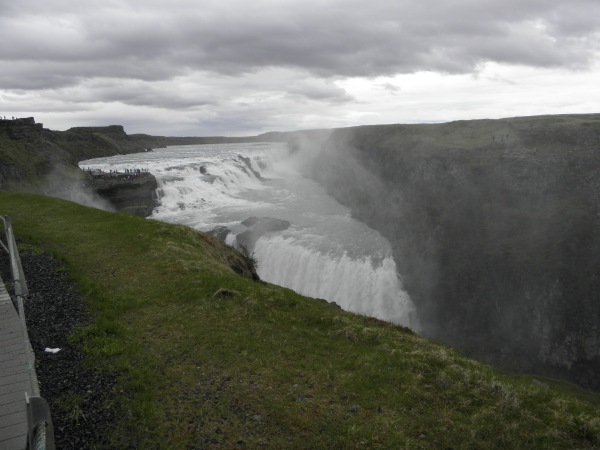
I’m rushing off tomorrow to London, UK for the American Indian Workshop (AIW) hosted this year by friends and colleagues David Stirrup and Padraig Kirwan. Stay tuned for lots of pictures and news from the conference. Lots of American Indian and First Nation friends will be there. Very excited to see everyone.
I recently co-authored a chapbook of poems with Irish poet Doireann Ní Ghríofa titled, Singing, Still, Libretto for the 1847 Choctaw Gift to the Irish for Famine Relief. The chapbook is a series of “call and response” poems dedicated to our ancestors, the Irish and the Choctaws who lived and died through the hunger years, suffering at the hands of colonialism. The chapbook poetry is trilingual, allowing English to form a bridge between our native languages. Here’s a link to our story that ran in the Irish Times. https://www.irishtimes.com/culture/books/famine-bonds-choctaw-and-irish-poets-combine-1.3130918
Until next time.
Friends, Readings, New Books, Conferences
These days part of the job of an academic and writer is to host readings by great writers. I know what you’re thinking: that’s not a hard job. Indeed it isn’t.
On January 24, I hosted University of San Francisco poet and scholar Dean Rader (Okie) to UGA’s campus. He was funded by the Eidson Foundation at UGA that also funds my chair. Dean gave a wonderful reading from his new book at Cine in Athens, GA. His new book Self Portrait as Wikipedia Entry as https://www.coppercanyonpress.org/pages/browse/book.asp?bg=%7B603C6409-E9AF-4F8F-B6BF-8BCECC32754A%7D is a great read and UGA was proud to be his premier reading for the new book just out from Copper Canyon Press.
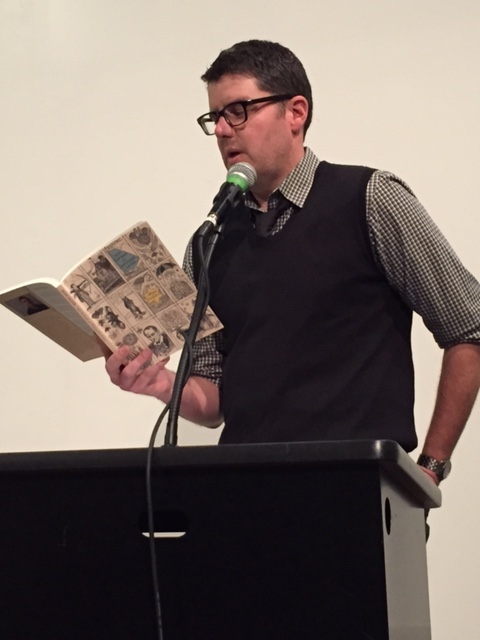
Also in January 2017, the Georgia Review hosted a reading by poet Jericho Brown (Emory University) on the UGA campus. He read from some of his new work. Both poets gave fantastic readings. UGA audiences live for poetry readings. 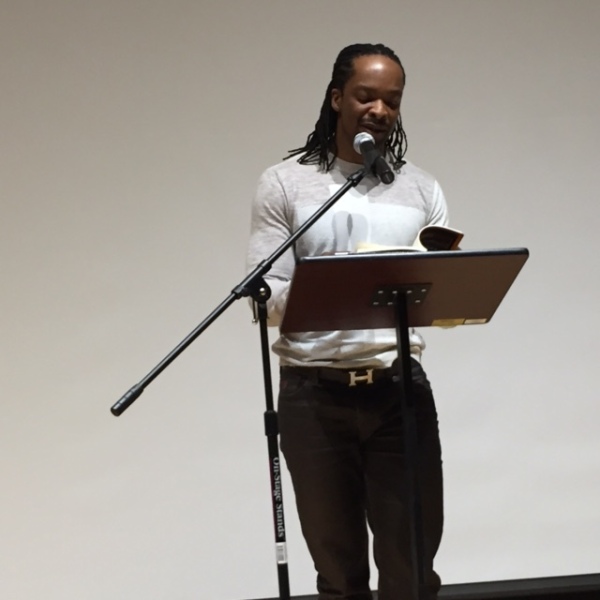
Last summer I was fortunate to have worked with Jericho Brown and Native poet Natalie Diaz at the Minnesota Northwoods Writers Conference in Bemidji held June 20-26 2016 at the American Indian Resource Center on the campus of Bemidji State University. Pictured below, left to right, are Brenda Child, me, Natalie, and Jericho at a local pizza restaurant in Bemidji. Brenda Child (Red Lake Ojibwe) is a historian at the University of Minnesota, and author of Boarding School Seasons, and most recently My Grandfather’s Knocking Sticks. https://indiancountrymedianetwork.com/history/events/growing-up-ojibwe-brenda-j-child-wins-award-for-historical-family-memoir/. In 2003, we were in Bilbao, Spain for a conference and she was consistently the best judge of Spanish red wines I’ve ever had the privilege of hanging out with! Brenda and I met in the Twin Cities years ago when I had a visiting writer position at Carleton College, Northfield, MN.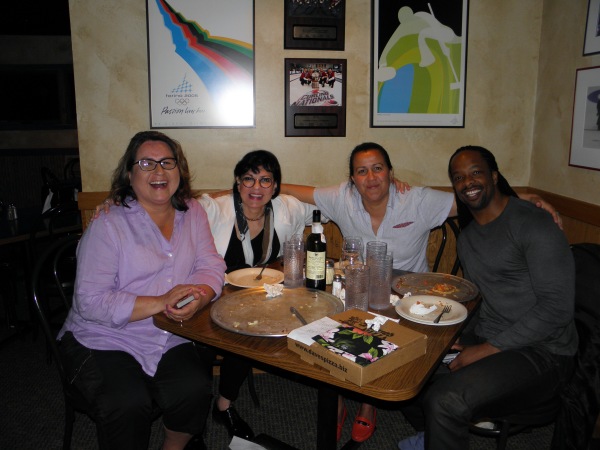 And speaking of the Twin Cities, this year the Native American Literature Symposium (NALS) was held at Mystic Lake Casino, just outside of Minneapolis, February 2-4, 2017. This was our 18th year to host NALS somewhere on Native land in the United States. I’m proud to have hosted Payton Guthrie, (Choctaw) filmmaker from the Choctaw Nation of Oklahoma, Durant. He gave the Friday night’s keynote lecture at NALS.
And speaking of the Twin Cities, this year the Native American Literature Symposium (NALS) was held at Mystic Lake Casino, just outside of Minneapolis, February 2-4, 2017. This was our 18th year to host NALS somewhere on Native land in the United States. I’m proud to have hosted Payton Guthrie, (Choctaw) filmmaker from the Choctaw Nation of Oklahoma, Durant. He gave the Friday night’s keynote lecture at NALS.
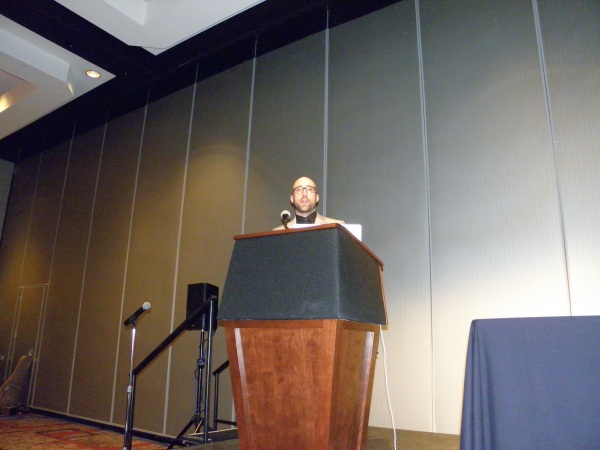
Keynote Payton Guthrie (Choctaw). His address was supported in part by the Eidson Foundation Fund, and the Choctaw Nation of Oklahoma, and NALS.
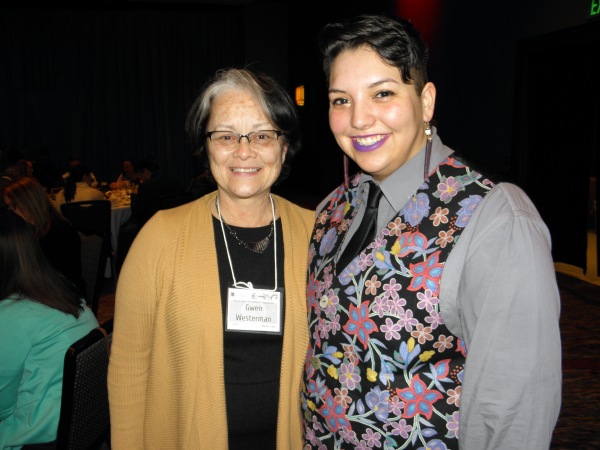 Some NALS photos from the conference below.
Some NALS photos from the conference below.
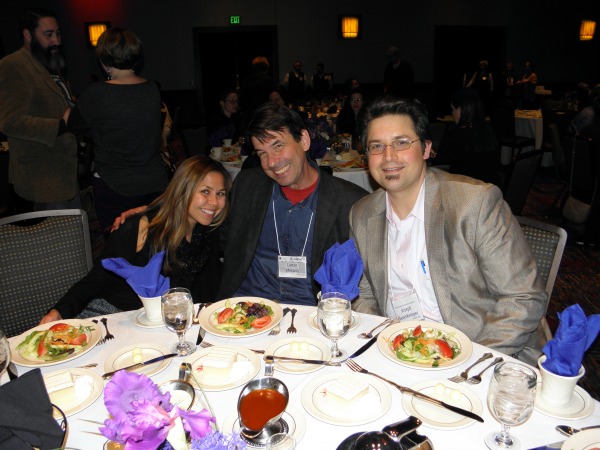
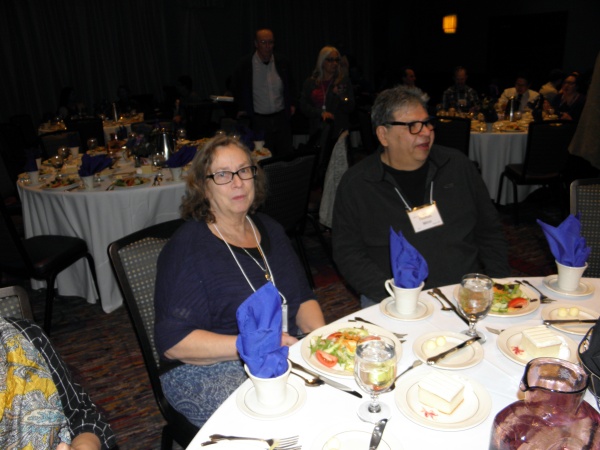
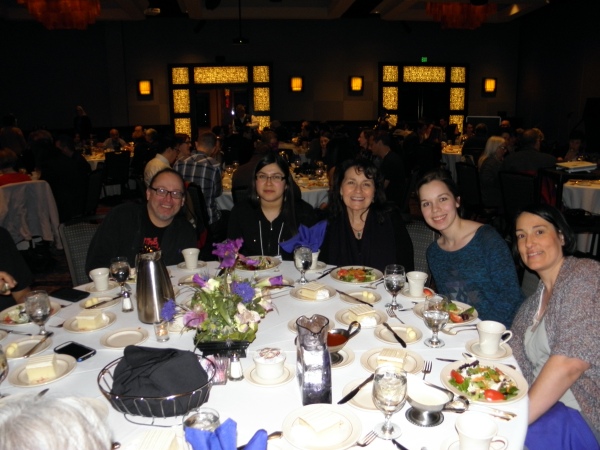
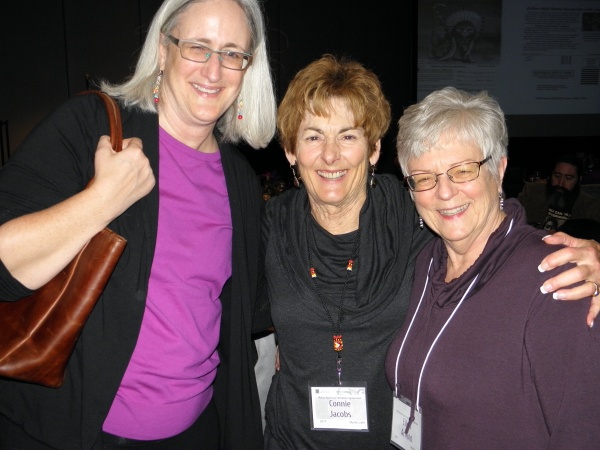
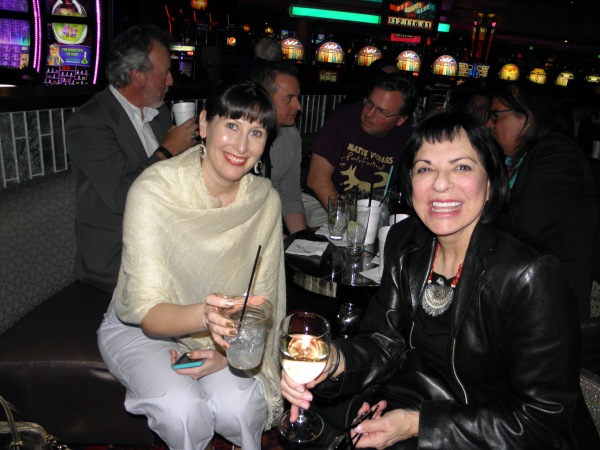
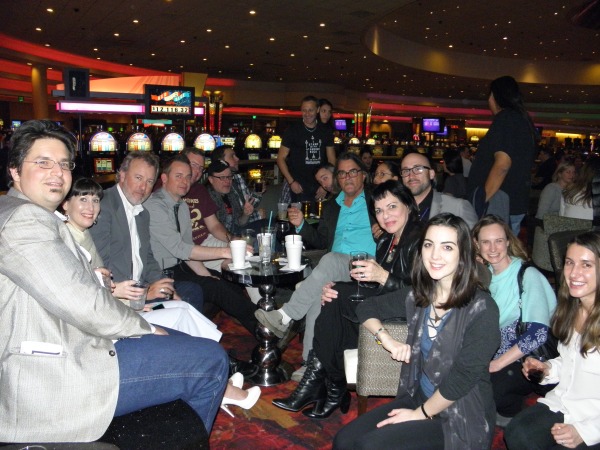 Below is a picture of my recent lecture at the University of Oklahoma, Norman, and it was my great pleasure to be home again. Will see what happens next!
Below is a picture of my recent lecture at the University of Oklahoma, Norman, and it was my great pleasure to be home again. Will see what happens next!
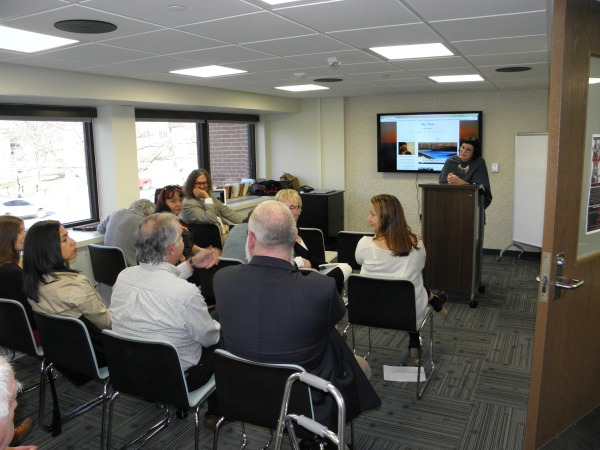 Stay tuned.
Stay tuned.
“Quote The Raven Nevermore”
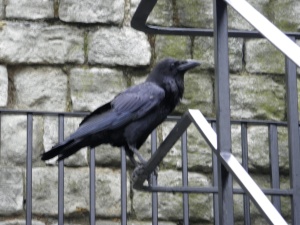 “But the Raven still beguiling all my fancy into smiling,
“But the Raven still beguiling all my fancy into smiling,
Straight I wheeled a cushioned seat in front of bird, and bust and door;
Then, upon the velvet sinking, I betook myself to linking
Fancy unto fancy, thinking what this ominous bird of yore —
What this grim, ungainly, ghastly, gaunt, and ominous bird of yore
Meant in croaking, Nevermore.” – Edgar Allen Poe, 1845
Why a picture of Queen Elizabeth’s raven near the Tower of London and the quote from Edgar Allen Poe? Well, we just had the warmest Halloween ever in the US and I was longing for the cold. But the truth is the picture was taken on June 1, 2016 in the coldest winter I ever spent last summer in London, to misquote Mark Twain. Honestly last June, the temperatures were in the 40s with gail winds most of the week we were in the Queen’s city. We had traveled from Atlanta to Denmark, and onto London.
Short non sequitur. While in London, Padraig Kirwan and I gave a public presentation at Goldsmiths University of London on The Trans-Atlantic Choctaw Irish-Exchange 1847-1995, a book of essays by Choctaw scholars and Irish scholars about the gift from the Choctaws (money) in 1847 to the Irish during the terrible potato famine in that country.
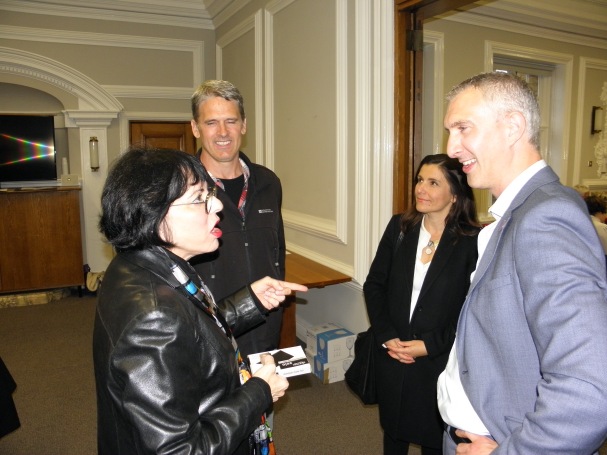
Here we are in London
Talking briefly before our lecture Goldsmiths University on June 1, 2016, Padraig Kirwan, (front right) we chatted with friends and colleagues. (Back left, western writer Emry McAlear and his wife, Brigitte McAlear now living in London came to the lecture.) Emry is an alum at Vermont College of Fine Arts. I was fortunate to work with him on his collection of essays, Townie Boy, at VCFA. His award-winning essays on life in Montana are both poignant and funny.
Back to the Tower of London.
I took the photo at the Tower of London complex where legend has it that six ravens must guard the Tower of London at all times or the monarchy will fall. (I’m quoting from the Tower’s PR.) We walked around and took a tour. Crimony, throughout history over 3,000 people have had their heads removed off at the Tower of London, including Anne Boleyn, former wife of Henry VIII. (And they called Indians savages.) They killed her in mid-prayer, so said the Beefeater giving us the tour. He said her mouth kept moving for 28 seconds after they lopped off her head. Who had the terrible job was counting the seconds?
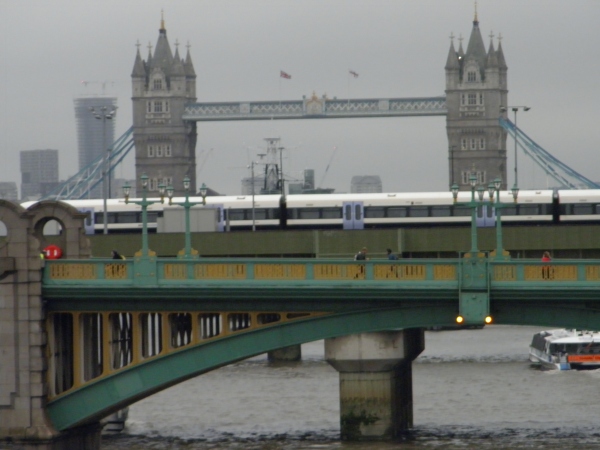 View of the Thames River from the Tower site.
View of the Thames River from the Tower site.
As we walked central London, near the Foundling Home and Charles Dickens House and museum site, we passed a school that raises goats. Kinda awesome when you think this is central London.
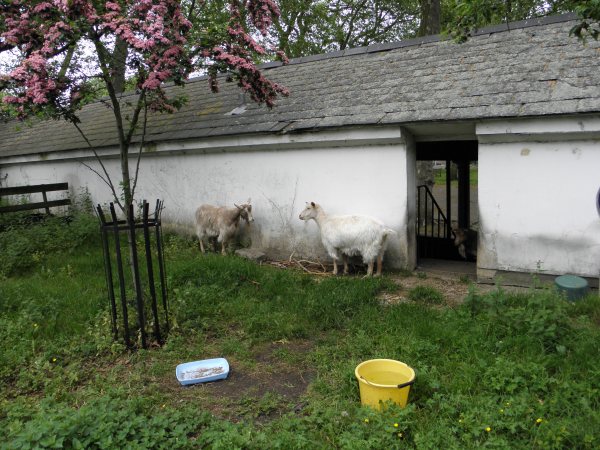
The goats Of London. Not far from the Halingford Hotel, a great place to stay when in London, is a schoolyard of goats. For milk I presume. But in all the hustle and rumble of central London this two-acre urban farm is a welcome respite.
A week before the June trip to London we’d traveled to Copenhagen, Denmark to give papers at the 37th Annual American Indian Workshop held in Odense, Denmark. The theme was Indian humor. . . Aside: there was a dust up among European colleagues about how one knows Indians are funny. Little Big Horn massacre leaps to mind. . . We reconnected with friend and historian Susan Sleep Smith, Michigan State University, her paper on Indian and French humor was fantastic. She and I met at a 1995 NEH summer seminar at the University of Oklahoma. That summer is when I met historian Jacki Rand (Choctaw) and we’ve stayed in touch all these years later. She’s one of the scholars writing for a chapter for The Trans-Atlantic Choctaw Irish-Exchange 1847-1995 that Padraig and I are editing. In fact Jacki’s house in Ada, Oklahoma is right across the street from mine.
Moving at a snail’s pace on this summer 2017 travelogue, (ah hem) while in Odense, Denmark, we visited the Museum of Hans Christian Andersen. Below. His work has been translated into 125 different languages and the copies of the breadth of these translations are in the Odense museum. It was impressive to see all the texts translations. 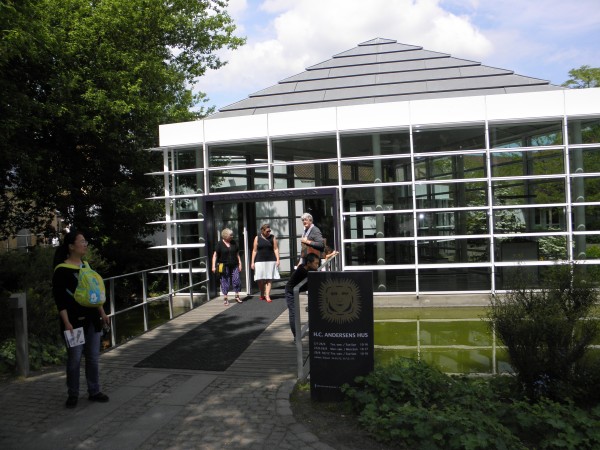
Jim Wilson is standing far right from the entrance to Hans Christian Andersen Museum in Odense.
Before Denmark and before London, we’d traveled this summer to the Native American and Indigenous Studies (NAISA) conference in Honolulu, Hawaii. Jim Wilson and I gave papers (he did) and I chaired a panel at the conference. Pictured here with a dear friend Professor Noenoe Silva (Native Hawaiian) whose seminal work, Aloha Betrayed, I teach from. She has a new book coming out soon.
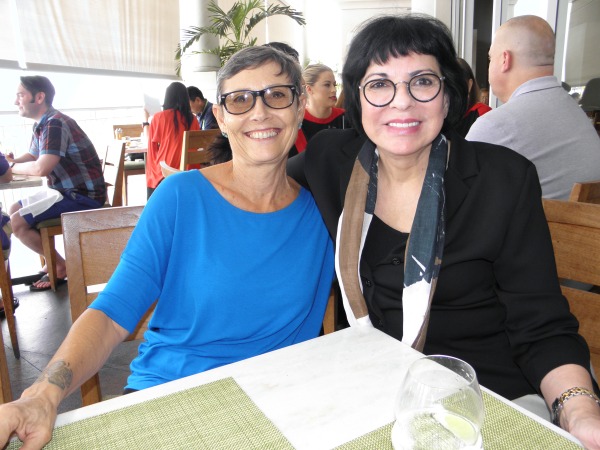
While at NAISA, I got to see, and at least hug one of my graduate students from the University of Illinois, Eman Ghanayem, and Dr. Theresa Rocha. Congrats Theresa on completing your PhD this past year. What a treat to see you both. Coming next: the future books I want to read. Aren’t you glad the US Presidential Election is almost over!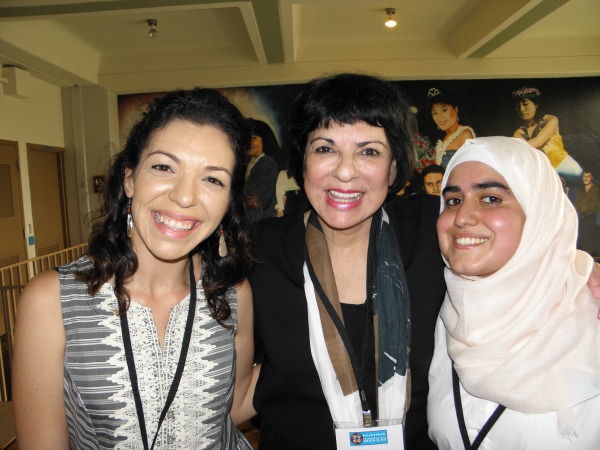
Travels and New Paths On the Horizon
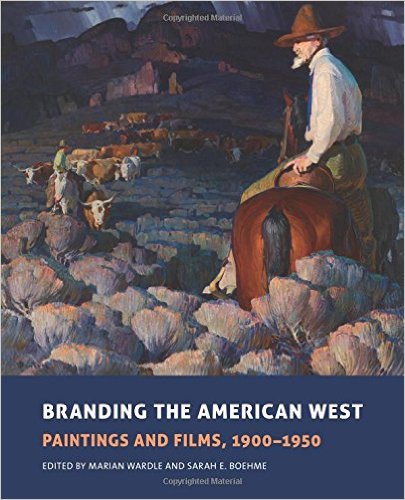
Over the past five months I’ve traveled a great deal, made new friends, connected with old friends, and read a few new books, even given readings from my new manuscript. This blog post is perhaps more of a diary entry because it helps me remember where I’ve been. And where I’m going.
On March 2, 2016 I traveled to Brigham Young University in Provo, Utah for the Branding the American West Symposium, and to celebrate the publication of the book (above) by the same name. My friend, poet and scholar Dean Rader got me involved in the book project and art exhibition about two years ago. We all had various assignments, his was to write about art and landscapes. His essay, “Part of the Strangeness, Notes On Landscapes And the American West,” tackles artists such as Walter Ufer, Maynard Dixon, and Kenneth Miller Adams, among others, and discuss the tensions in their work. My assignment was to write about classic Hollywood movies and representations about Indians. “Imagine There’s No Cowboy, It’s Easy If you Try,” is about images in films that portray American Indians as “savages.” It’s a first person account of growing up in Oklahoma and watching bad Westerns on tv every Friday night and hoping that just once the Indians would defeat the cowboys. It never happened. Today the academic industry of critical inquiry known as “settler colonialism,” frankly does nothing to alleviate the suffering of “the person[s] to whom things happen,” paraphrasing Virginia Woolf. Uh-hem.
In Branding The American West, Rader’s essay opens the book and mine closes it. Call us bookends. The lovely coffee table book, edited by Marian Wardle and Sarah Boehme, is filled with essays about the west. Authors included are: Jon Ott, Jimmy L. Bryan, Susan Rugh, and Elizabeth Hutchins. Check it out at your local bookstores or online. 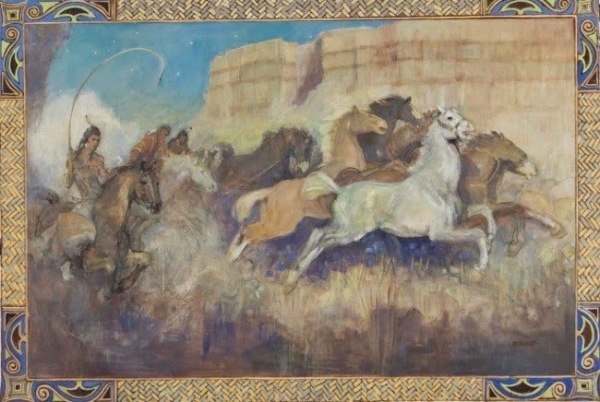
Minerva K. Teichert’s Stampede in the Canyon.
I love Teichert’s painting, it’s large and very romantic and I think of it as a long shot in the 1950s tv show, The Lone Ranger. I also wrote about The Wind. Crimony, it’s one of the scariest silent films ever. The Wind is a good story and Lillian Gish is a remarkable actress. Her gestures in the silents are always on the mark, powerfully acted. But sad to say that in The Wind, American Indians are portrayed as menacing demons. Typical.
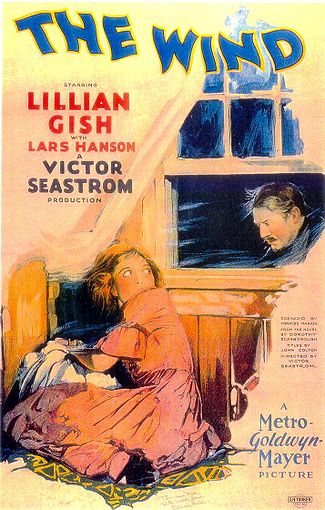
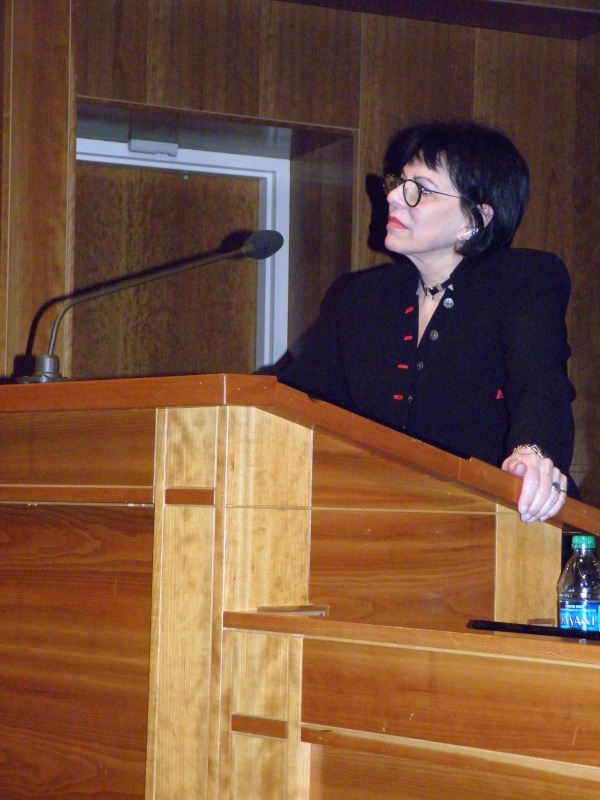
From the lectern, “Oh lord, give me strength these films are dreadful. “
Pictured below are some of the students from Patrick Madden’s (far left) BYU creative writing class that I got to meet while at the symposium. They asked great questions about the writing process, and how a writer chooses the stories he or she chooses to tell.
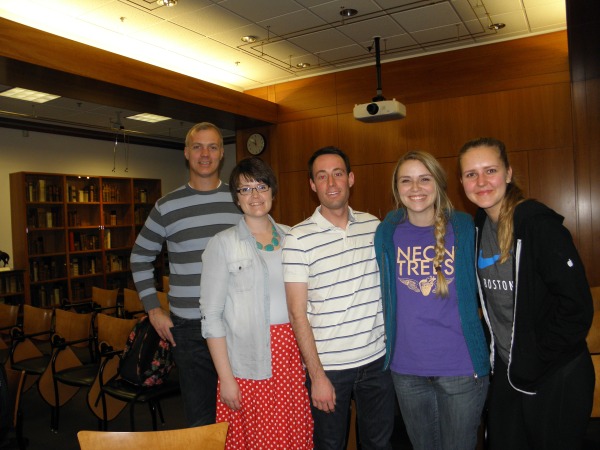
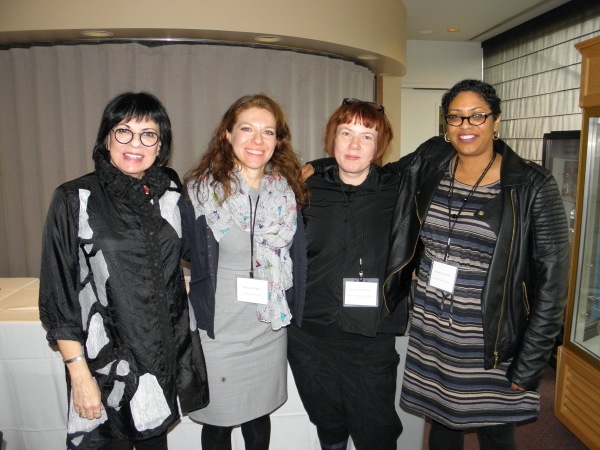 Some of the faculty from the USA and UK that attended the Branding The American West Symposium March 2016. Far right is Wendy Castenell, Assistant Professor of African American Art, University of Alabama.
Some of the faculty from the USA and UK that attended the Branding The American West Symposium March 2016. Far right is Wendy Castenell, Assistant Professor of African American Art, University of Alabama.
Searching for Sequoyah, A New Documentary Film in the Making
Beginning on March 9, 2016 we began filming interviews from our new documentary Searching For Sequoyah. The film is about the Cherokee genius Sequoyah who in 1808 began working on a system to write the Cherokee language. He worked in secret. Some people thought he was crazy. Others thought he must be practicing sorcery, threading sounds on an invisible symbol. Finally, in 1821, Sequoyah perfected his syllabary, a symbol set with one character for each syllable in the language—86 of them. It is the only indigenous writing system north of Meso-America.
Searching for Sequoyah’s co-producer and cinematographer James M. Fortier and myself, co-producer and screenwriter, are working along with Dr. Jace Weaver, Director of UGA’s Institute for Native American Studies, and University of Oklahoma professor Dr. Joshua Nelson (Cherokee) on the new documentary. We interviewed Sequoyah’s lineal descendants in Tahlequah, OK in March along with Dr. Daniel Justice, (Cherokee) who traveled from University of British Columbia, Vancouver for the film project. We are very grateful that he came for the filming. We will will likely continue to work on the project for the next couple of years. Perhaps longer. 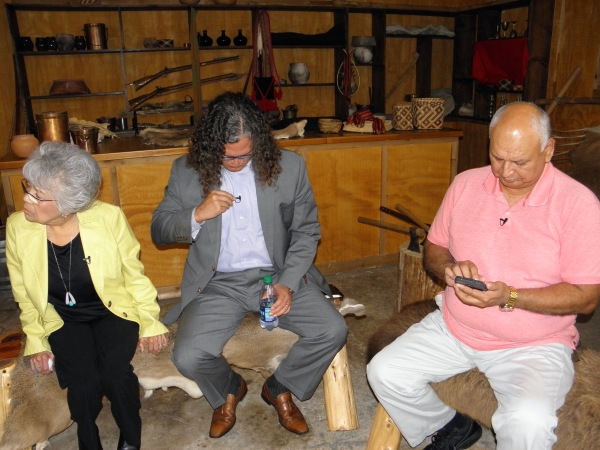 Pictured left to right. Winnie Guess Perdue, Joshua Nelson, and John Ross. Both Perdue and Ross are direct descendants of Sequoyah.
Pictured left to right. Winnie Guess Perdue, Joshua Nelson, and John Ross. Both Perdue and Ross are direct descendants of Sequoyah.
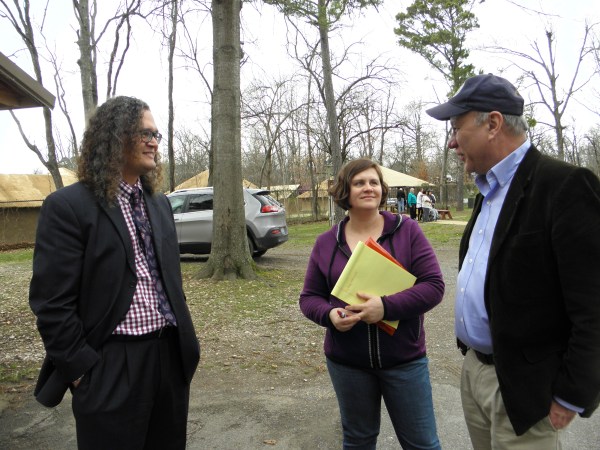 Left to right: Joshua Nelson, Grace Milley, and Jace Weaver on the grounds at the Cherokee Museum. March 2016.
Left to right: Joshua Nelson, Grace Milley, and Jace Weaver on the grounds at the Cherokee Museum. March 2016.
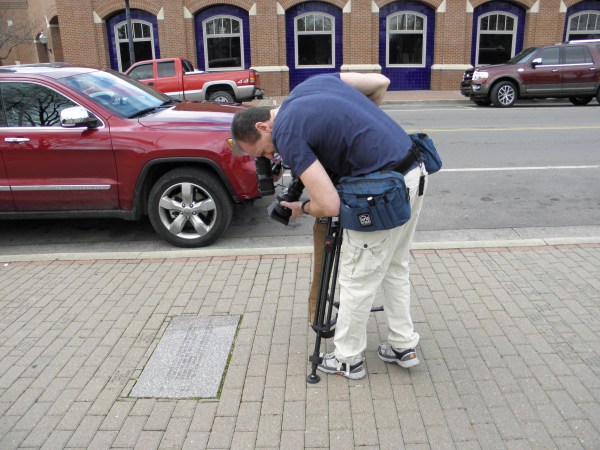 James Fortier filming in downtown Tahlequah.
James Fortier filming in downtown Tahlequah.
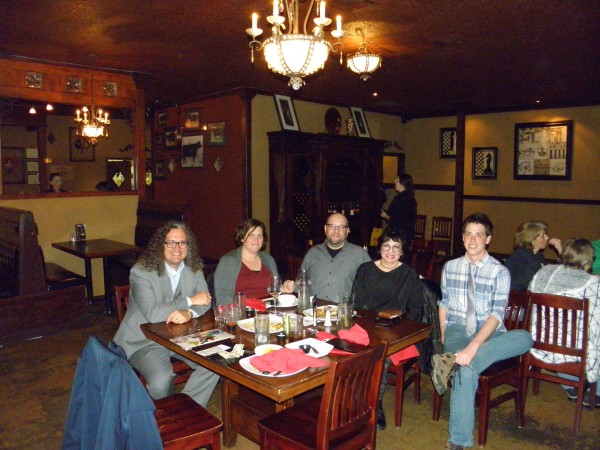 Left to right: Joshua Nelson, Grace Milley, Daniel Justice, (me) and Matt Jennings dining after a day of filming in Tahlequah.
Left to right: Joshua Nelson, Grace Milley, Daniel Justice, (me) and Matt Jennings dining after a day of filming in Tahlequah.
March 17-20, 2016 Native American Literature Symposium, NALS, Albuquerque, New Mexico.
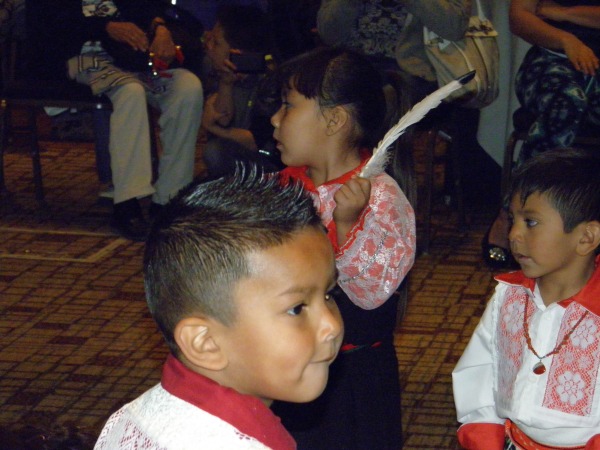 The highpoint of this year’s Native American Literature Symposium (NALS) 2016 was a children’s dance they performed for the conference goers. This is our 16th year for hosting NALS.
The highpoint of this year’s Native American Literature Symposium (NALS) 2016 was a children’s dance they performed for the conference goers. This is our 16th year for hosting NALS.
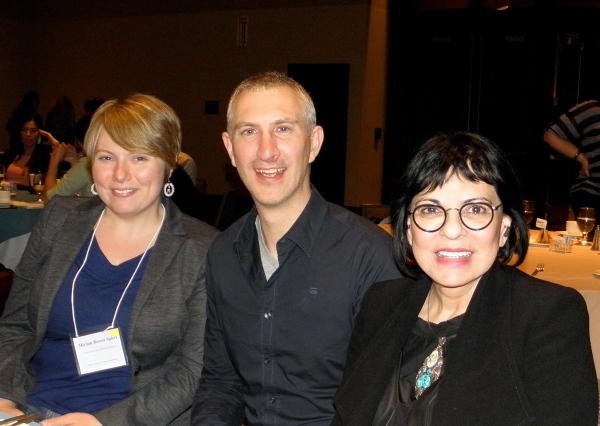 Pictured left to right are Miriam Brown Spiers, Padraig Kirwan, and myself, NALS 2016. Padraig and I are editing a collection of essays, “Transatlantic Reciprocity: Contextualizing Exchanges between the Choctaw & the Irish. “
Pictured left to right are Miriam Brown Spiers, Padraig Kirwan, and myself, NALS 2016. Padraig and I are editing a collection of essays, “Transatlantic Reciprocity: Contextualizing Exchanges between the Choctaw & the Irish. “
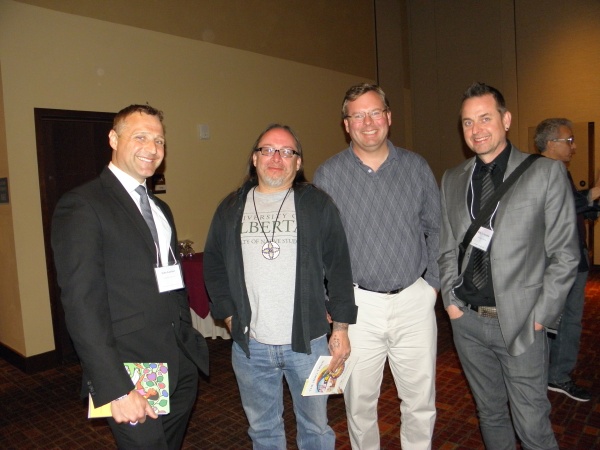 NALS academics 2016, Albuquerque.
NALS academics 2016, Albuquerque.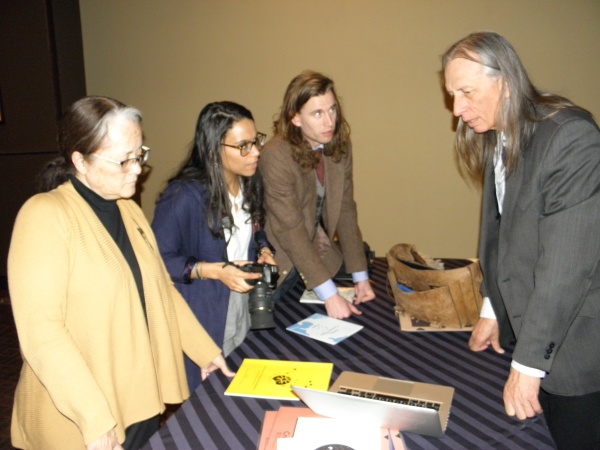 Gwen Westerman, left, NALS symposium director. Craig Howe, keynote speaker at NALS, 2016, far right, and creator of CAIRINS in South Dakota.
Gwen Westerman, left, NALS symposium director. Craig Howe, keynote speaker at NALS, 2016, far right, and creator of CAIRINS in South Dakota.
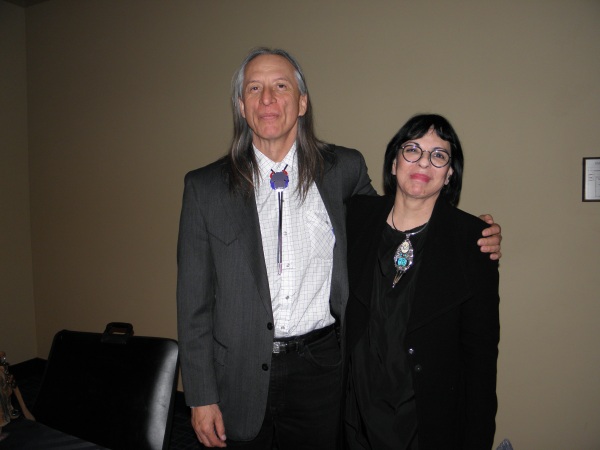 Indians sharing a dirty joke. NALS 2016. (I don’t know why I say such things. Everyone knows Indians don’t tell dirty jokes and we don’t laugh. Check out a classic Hollywood western, Indians are not laughing.)
Indians sharing a dirty joke. NALS 2016. (I don’t know why I say such things. Everyone knows Indians don’t tell dirty jokes and we don’t laugh. Check out a classic Hollywood western, Indians are not laughing.)
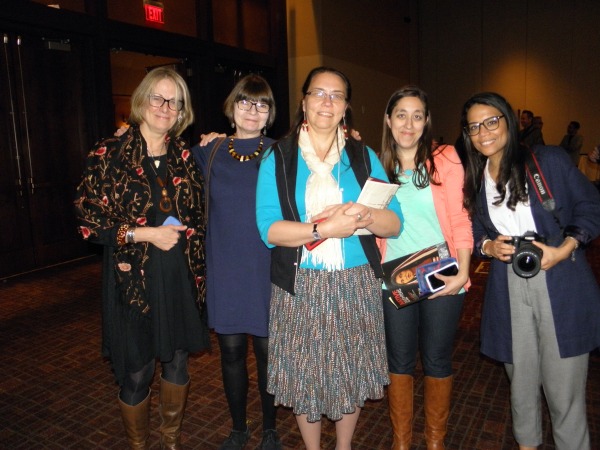 More NALS academics 2016. All friends and wonderful scholars.
More NALS academics 2016. All friends and wonderful scholars.
ABQ, New Mexico was fun, but it’s time to move onto AWP conference in Los Angeles, CA March 30-April 2, 2o16.
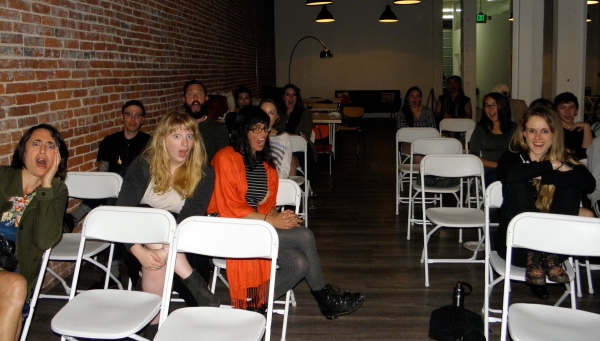 UGA’s Creative Writing Program hosted an off-site reading during the 2016 AWP conference in LA. We called our event, “shock and awe.” (Kidding.) Pictured here are UGA’s very excellent graduate students.
UGA’s Creative Writing Program hosted an off-site reading during the 2016 AWP conference in LA. We called our event, “shock and awe.” (Kidding.) Pictured here are UGA’s very excellent graduate students.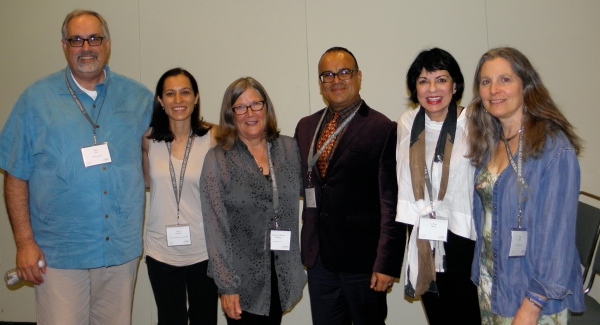 Pictured here with the Vermont College of Fine Arts 35th Anniversary Reading group. We all read from our new work. Left to right: Bret Lott, Neela Vaswani, Alison Deming, Rigoberto Gonzalez, me, and Ellen Lesser.
Pictured here with the Vermont College of Fine Arts 35th Anniversary Reading group. We all read from our new work. Left to right: Bret Lott, Neela Vaswani, Alison Deming, Rigoberto Gonzalez, me, and Ellen Lesser. 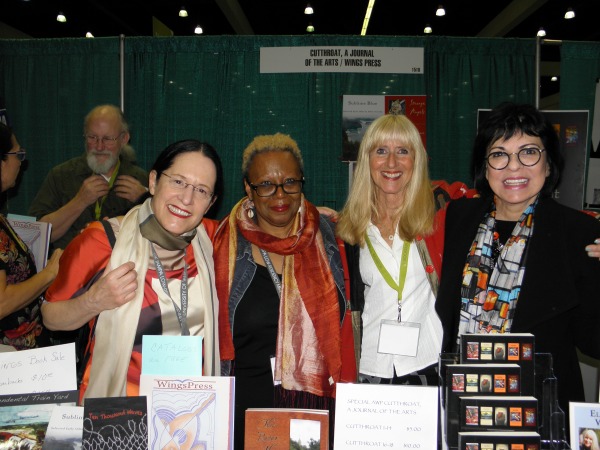 Here we are at the book signing for Cutthroat Journal’s beautiful new anthology at AWP 2016.
Here we are at the book signing for Cutthroat Journal’s beautiful new anthology at AWP 2016.
AWP 2016. LA has some cool restaurants. See the blue flame below.
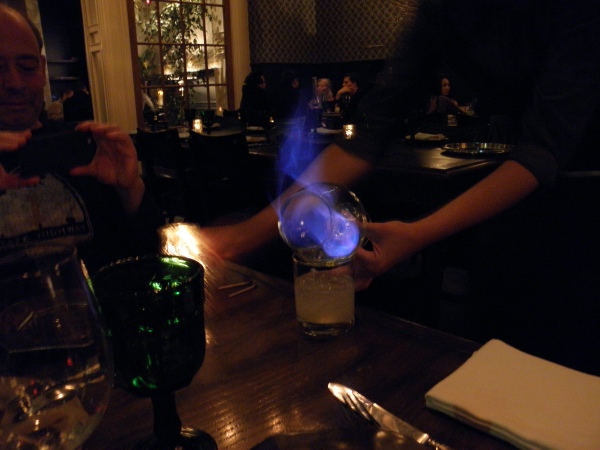
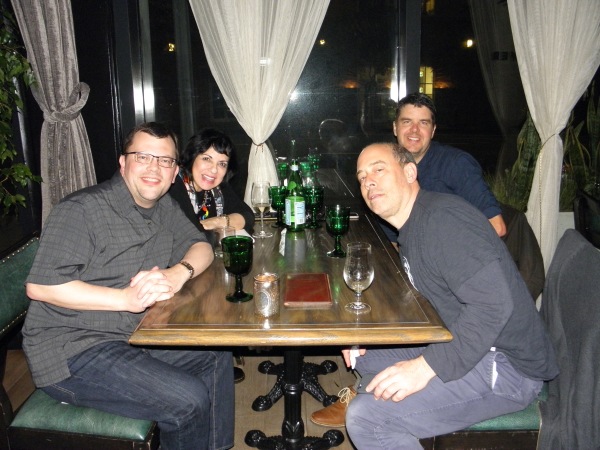 “After the absinthe.” See the blue fire in the glass in the picture above, 2016. Left to right. Chris, (me), Dean Rader, Jonathan Silverman.
“After the absinthe.” See the blue fire in the glass in the picture above, 2016. Left to right. Chris, (me), Dean Rader, Jonathan Silverman.
Hot Off the Press: Red Ink
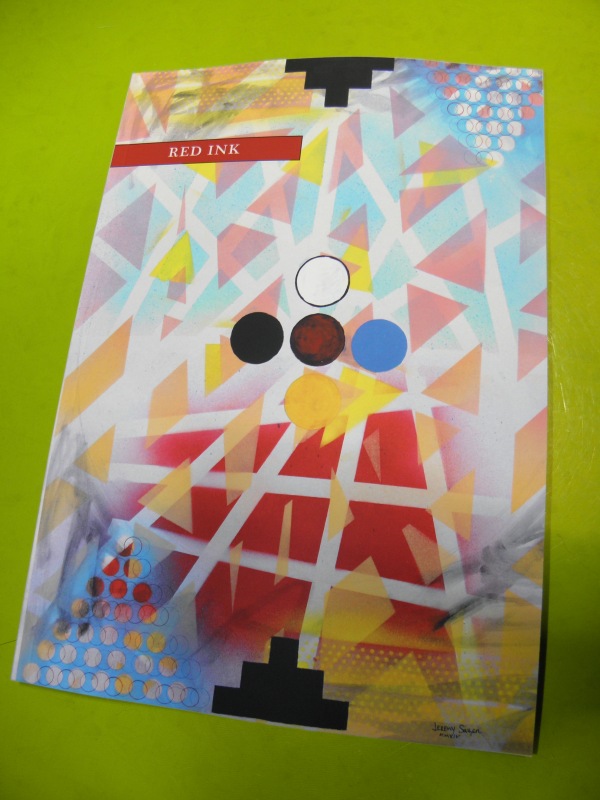
Red Ink. Spring 2016. Issue 18.1 contains poetry, fiction and drama, an interview with Sherman Alexie.
That takes me up to my visit at Pembroke NC, and my visit to University of North Florida. I”ll save that for another post. Yeah, like I said, this is mostly a diary of what I’ve been doing the last eight weeks or so. It’s been a busy semester, but I’ve managed to read two great new books, Olio O by Tyehimbia Jess, and handholding: 5 kinds by Tracie Morris. Check’em out. As for me I’ve completed a new book manuscript. Will see what happens next.
What I’m Reading And Re-Reading in 2016
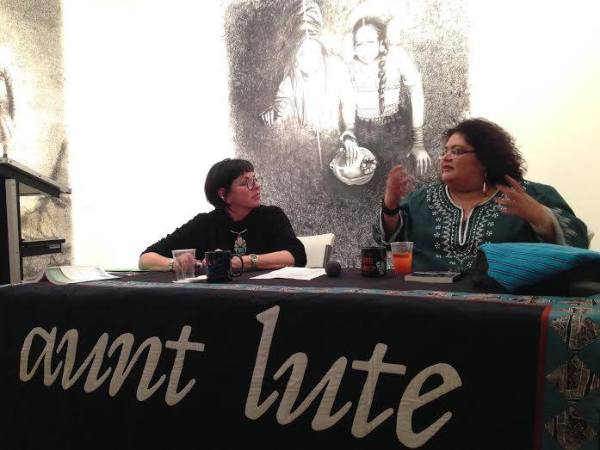 From “Our Indigenous Flesh” a reading and discussion event sponsored by our press, Aunt Lute Books on September 24, 2015, Galeria de la Raza in San Francisco, CA.
From “Our Indigenous Flesh” a reading and discussion event sponsored by our press, Aunt Lute Books on September 24, 2015, Galeria de la Raza in San Francisco, CA.
I’m re-reading Ire’ne lara Silva’s Flesh to Bone, (Aunt Lute Books 2013). A brilliant collection of nine stories of myth and fire and ultimately transformation. The prose is stunning.
Other books I’m reading are Ed Pavlic’s Who Can Afford to Improvise? James Baldwin and Black Music, the Lyric and the Listeners. A great read. My favorite chapter is “Shades Cannot Be Fixed, On Privilege, Blindness, and Second Sight.”
For a change of pace check out Paris Was Ours by Penelope Rowlands. She’s gathered writers and essayists such as C.K. Williams, Simon Shimon, David Sedaris, Julie Lacoste and many others who talk about their lives since moving to Paris. The essays made me wish I’d emigrated to Paris about fifteen years ago. Alas. I know, I know Paris has been badly abused in 2015, but the Parisians refused to be broken in spirit by terrorists. Good for them. I would love to move there for a year, or ten, but that will have to wait for a while until I can save a ton of money.
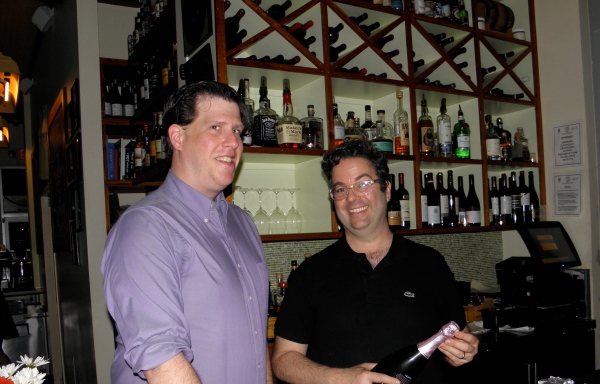
Patrick, left, Brian right, the Heirloom Cafe, New Year’s Eve 2015.
Since moving to Athens, Georgia in August 2014, I’ve made a good habit of dining at the Heirloom Cafe on Chase Street. This New Year’s Eve I took a break from reading and writing and had another incredible meal at Heirloom. Four courses paired with delicious wines. And we began with champagne. A great part of the charm of Heirloom are the baristas, chefs, and sommelier. Picture above are Patrick (sommelier) and Brian, (he makes the best martinis in the entire universe) two foodies and fab hosts, and friends, at the Heirloom. I highly recommend the restaurant. It’s my home away from home. 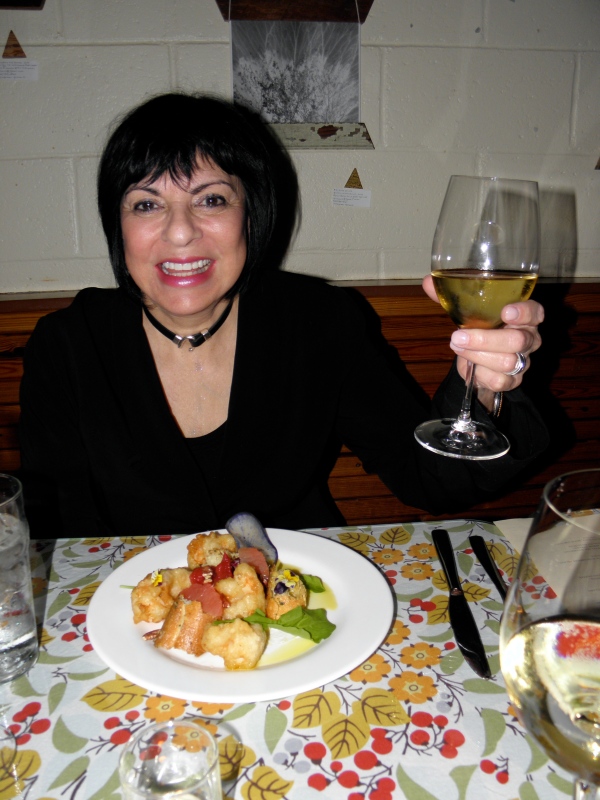
At the Heirloom Cafe, New Year’s Eve. Cheers!
After eating and drinking my way to New Year’s Day, I sat on the couch and re-read Dr. Tatiana’s Sex Advice To All Creation by Olivia Judson. It’s written from the point of view of moorhens, stick insects, fig wasps and many other creatures great and small all asking for sex advice. It’s smart, funny and just the kind of book you will want to read after too many glasses of bubbly. This from page 69.
Dear Dr. Tatiana,
My name’s Rob, and Im a bedbug. Xylocoris maculipennis. I’ve read that if I have sex with my friend Fergus, he’ll deliver my sperm when he next has sex with Samantha. Is this for real?
Making Mischief between the Sheets
See what I mean. Something for everyone. I tend to read this book about every 2 years since it first came out.
Also on my bedside table is a copy of Jimmy Carter’s Our Endangered Values: American’s Moral Crisis. After watching my fill of this year’s Presidential debates and how the candidates snipe at each other, I recommend reading instead of watching television. The Presidential election has become a race of proliferating nonsense. See Carter’s chapter “Attacking Terrorism, Not Human Rights.”
As for me it’s back to teaching beginning January 11, 2016. My new course is The Walking (un)Dead: American Indians as Zombies, Ghosts, and Ghouls in 20th century novels. (Again, something for everyone.) I’ve long thought American Indians are the original zombies at least as far as stereotypes go. In my future blog posts in coming months I’ll be posting about how the course is going. And other events.
Etowah Mounds: The Place To Be One Thousand Years Ago!
Spring At Last!
Georgia! Thank goodness the cranky weather, cloudy, rainy holidays like St. Patrick’s Day, freaky ice storms — are behind us now. Just in the nick of time. March has been a bit of a knicker-pincher in terms of the events I’ve hosted beginning on March 5, 2015 with Lo! The Poor Indian No More: The Trans-Atlantic Choctaw Irish Exchange 1848-1995, A Colloquium at the Russell Special Collections Library at the University of Georgia.
In 1847, the Choctaw Indians at Skullyville, Indian Territory were saddened to hear the news of the starvation in Ireland due to the potato famine. The Choctaw had experienced starvation only sixteen years earlier, when the entire Choctaw Nation of people were forced to walk west by Andrew Jackson’s government. The event is known as the Trail of Tears. Choctaws were the first to be “removed” out of Southeast and their ancient homelands. The Nation lost one quarter of its population. Fast-forward to Skullyville, Indian Territory. The Choctaws collected $170.00 (or $710.00, there’s a controversy about the money) and forwarded the funds to the U.S. famine relief organization. 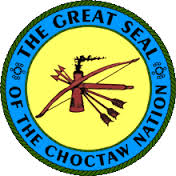
Paul Gleeson, Consul General of Ireland, Atlanta began our event on March, 5, 4:30 p.m., at the University of Georgia and told us that incredible as it sounds, Ireland’s population has never recovered from the famine disaster of 1847-1848. Before the famine Ireland’s population was eight million. 168 years later the population of Ireland is barely six million. 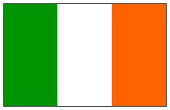
The panelists for the colloquium were Jacki Rand, (citizen, Choctaw Nation of Oklahoma), associate professor of history at the University of Iowa; Padraig Kirwan, Senior Lecturer in the Department of English and Comparative Literature, at Goldsmiths, University of London, UK; Peter D. O’Neill, Assistant professor in the Comparative Literature Department at UGA; Jace Weaver, Franklin Professor of Native American Studies and the Director of the Institute of Native American Studies at UGA, and me. We had a marvelous crowd of about 90 people, a mix of the public, students and faculty and I’m so grateful for the support everyone has shown me. The March 5 event was to kick off our book-length project on the history of the Irish Choctaw exchange. Pictured below, left to right, Padraig Kirwan, Peter O’Neill, Paul Gleeson, Jace Weaver, Jacki Rand, and me. 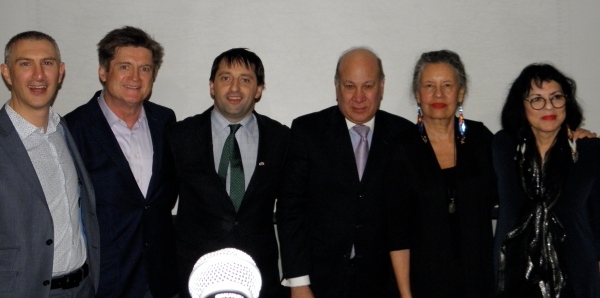
Following the Choctaw Irish Colloquium, the UGA Creative Writing faculty flew to Missoula, Montana for “Thinking Its Presence: The Racial Imagery” March 12-14, 2015, a conference on race in the 21st century. The panel reading was Thursday afternoon and organized by poet and fiction writer, Maggie Z. Her new book Companion Animal is coming out in a few hours, (actually April 1) congratulations Maggie. See back and front below. Cool, beans, huh!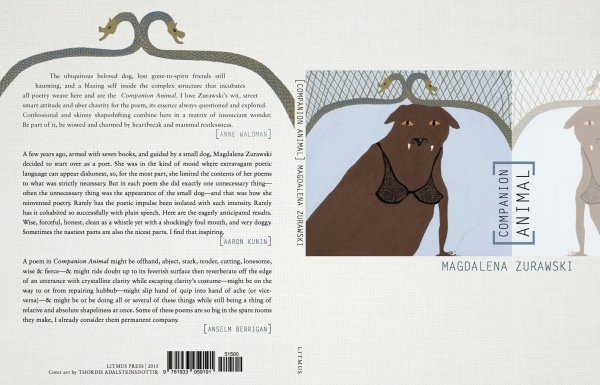
Pictured below are the UGA creative writers, left to right, Magdalena Zurawski, Gabriel Fuentas, Shamala Gallegher, and Ed Pavlic. The next day I had to leave Missoula, Montana and fly to Albuquerque, New Mexico for the Native American Literature Symposium (NALS), March 12-14, 2015. I’ve been part of the organizing group that’s hosted NALS for the past 16 years. We’ve always held the conference on Native land, another important aspect of the conference.
Pictured below are NALS regulars at the Isleta Casino where the conference was held this year. I can hardly believe it, that 16 years have passed so quickly. I’m very proud of all the literary scholars that have come through NALS over the years.
My last event to host in March at UGA is a reading by Susan Power, author of the 2013,
Sacred Wilderness, Roofwalker, and The Grass Dancer. Power’s reading, March 26, 2015 will be at 4:30 p.m. at the North Auditorium on the UGA campus. Power is also reading and signing books at Avid Books in Athens, GA from 6:30-7:30 p.m.
Next, the UGA CW faculty will be reading at Cine Theater on Hancock in Athens, GA March 31, 2015 from our work. 7 p.m. (I’ll be reading new poems.)
On April 4, 9:30 p.m. I’ll be reading at the Scissortail Creative Writing Festival, East Central University, Ada, Oklahoma. YAH!
In Passing: Greg Rodgers, 1968-2014
Summer of 2014. Early June as I recall, not too hot, not too humid. Greg Rodgers, Eman Ghanayem, and me. Two Choctaws and a Palestinian from Hebron, West Bank, out for a summer joy ride in Atoka County, Oklahoma, home to Choctaws. Eman and Greg were both graduates students at the University of Illinois. They’d come to visit me in Ada, Oklahoma. For some reason we decided to drag Eman to all the famous sites in Oklahoma. We took her to the Sonic Drive-in on Mississippi Street in Ada, Oklahoma. Then to the Choctaw Nation’s headquarters in Durant. Then out to the casino and all the food courts were closed. WTF?! Greg then directed us to Boggy Depot where he pointed out the graves of his kinfolks on the Folsom side of his Choctaw family.
Pictured below, Greg Rodgers and I are standing looking at the map of Boggy Depot. 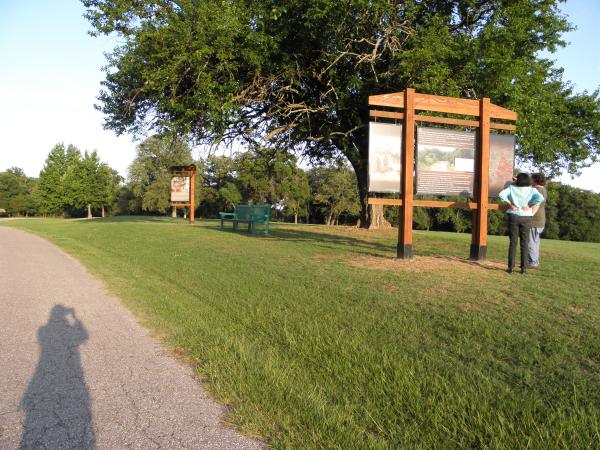 You can see Eman’s shadow, (left) as she snaps a picture of us studying the map of the area. We spent the afternoon looking at Choctaw headstones, calling out the names of ancestors. We walked around the site, mostly trying to steamroll Eman. Since she’d never been to Oklahoma we told her she was our “captive.” She yawned. Not a good sign. Next we decided to educate her with a piece of disputed history: Thanksgiving. She tried to change the subject.
You can see Eman’s shadow, (left) as she snaps a picture of us studying the map of the area. We spent the afternoon looking at Choctaw headstones, calling out the names of ancestors. We walked around the site, mostly trying to steamroll Eman. Since she’d never been to Oklahoma we told her she was our “captive.” She yawned. Not a good sign. Next we decided to educate her with a piece of disputed history: Thanksgiving. She tried to change the subject.
“What is the history of awkwardness?” she asked. Clever girl. Greg intervened. “What is a “derivative” in the stock market?” he countered. “Touché,” I shouted. Seeing that we were deadlocked in a battle for our wits, we halted the chit-chat. Instead, we told Eman all the things Choctaw captives must do to become fully “Choctawized,”
1) Buy us lots of coca-cola.
2) Buy us lots of gasoline for the car — after all these sightseeing trips cost money.
3) Take pictures of us that make us look “wise.”
4) Listen to endless boorish stories about the “greatest red people of all: The Choctaws.” Did I mention that Choctaws are braggarts?
After joking around all day with Eman and Greg, I remember a profound sense of serenity came over me. That was truly a halcyon day last summer, one I will never forget.
Greg passed away quite suddenly on December 17, 2014, — he left us with nothing but good memories. He was just about to finish his MFA a the University of Illinois, where he was working on a great novel-in-progress. Illinois will grant him the MFA in Creative Writing posthumously in April 2015. He had written enough for two books. 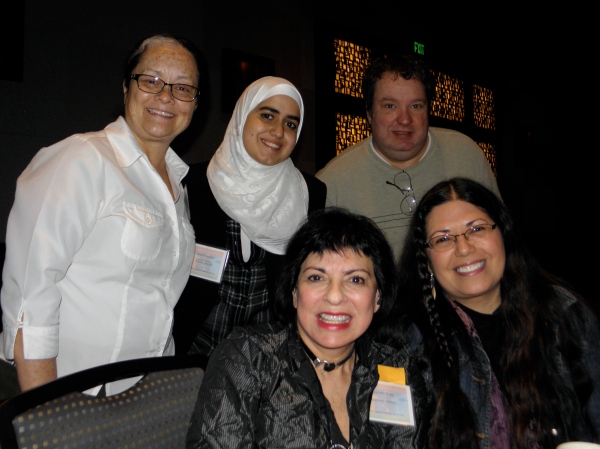
On February 20, 2015, the Native American House at Illinois is hosting a memorial for Greg Rodgers and everyone is invited to attend. Check out the website: http://illinois.edu/calendar/detail/1534/32480945
Pictured above, standing, are Gwen Westerman, Eman Ghanayem, and Greg Rodgers. Seated, me and Susan Power.
It’s been hard to write about Greg’s passing, he was family and I dearly loved him. I’d recruited him to Illinois into the MFA program in Creative Writing in English where he excelled. We shared a passion for Choctaw history, culture and language. We liked to pretend we were the original “Choctaw chucklers,” always joking around about this, that, or the other. Greg, I know you’re watching us from the other side and telling the friends and family around you, “about the time . . . ”
You are so right. “In the end all you are is your Story.”
We miss you, chi kana.
Embodiment and Native Theatrical Praxis
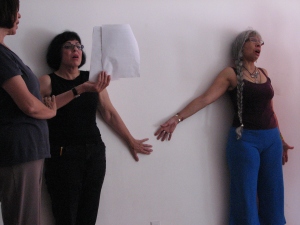
Pictured Brenda Farnell, LeAnne Howe and Monique Mojica working in the studio in Toronto, Canada. (Photo by Ric Knowles)
Over the past four years I’ve been working on a new play coauthored with Monique Mojica (Rappahannock and Kuna). I say “co-authored,” but I should include our design team and especially the lands we’ve been working on as co-collaborators in the process of developing a healing ceremony, or play. Our team includes designers Dustin Mater (Chickasaw), Marcus Amerman (Choctaw), Tyra Shackleford (Chickasaw), James Wallace (Choctaw), composer Jerod Tate, (Chickasaw), costume designer Erika Isherhoff, lighting designer Michel Charbonneau, props Tim Hill, anthropologist and embodiment praxis scholar Brenda Farnell (University of Illinois), body movement specialist Danielle Smith (Toronto), dramaturge and literary scholar Chad Allen (Ohio State University), and theater director and dramaturge Ric Knowles (University of Guelph). The four-year project, “Indigenous Knowledge and Contemporary Performance” has been funded by Social Sciences and Humanities Research of Canada (SSHRC) and is about the recovery of indigenous knowledge, not Native victimization stories, per se.
The project addresses research questions about the recovery, renewal, and use of Indigenous forms and epistemologies in the creation and annotation of contemporary Native theatre and performance. 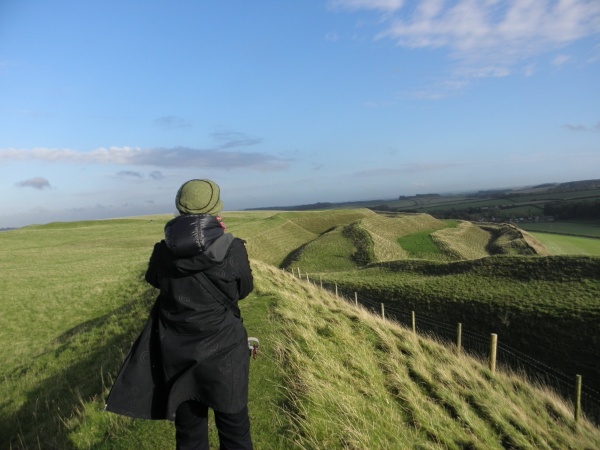 Our research methodology is located within an embodied research/creation (or practice-based research process), meaning we’re using our physical bodies to locate certain stories that tribes wrote into the land as they were creating mounds and Earthworks across Native North America. Since 2011, we’ve visited earthworks sites all across the continent from the Snake Mound in Peterborough, Ontario to the Bird Mound at Poverty Point, Louisiana and dozens of sites in between. We also visited Mai Don mound site in southwest England such as in the photograph above. Other mound sites include Nanih Waiya, (shown far below), and Newark, Ohio (below). We hope to have the new play produced in 2016. We also traveled to New York City’s Coney island Sideshow School in 2013 and learned how to escape from strait jackets, (pictured below) walk on glass, swallow fire. I didn’t attempt to swallow fire, I knew I would freak out, inhale, and die with collapsed lungs. All this research is going into the new play titled, “Sideshow Freaks and Circus Injuns.” It’s complicated, I know. Stay tuned for more updates on our progress throughout 2015!
Our research methodology is located within an embodied research/creation (or practice-based research process), meaning we’re using our physical bodies to locate certain stories that tribes wrote into the land as they were creating mounds and Earthworks across Native North America. Since 2011, we’ve visited earthworks sites all across the continent from the Snake Mound in Peterborough, Ontario to the Bird Mound at Poverty Point, Louisiana and dozens of sites in between. We also visited Mai Don mound site in southwest England such as in the photograph above. Other mound sites include Nanih Waiya, (shown far below), and Newark, Ohio (below). We hope to have the new play produced in 2016. We also traveled to New York City’s Coney island Sideshow School in 2013 and learned how to escape from strait jackets, (pictured below) walk on glass, swallow fire. I didn’t attempt to swallow fire, I knew I would freak out, inhale, and die with collapsed lungs. All this research is going into the new play titled, “Sideshow Freaks and Circus Injuns.” It’s complicated, I know. Stay tuned for more updates on our progress throughout 2015!
A Night at MLA in Vancouver, BC 2015
 The Modern Language Association’s awards ceremony was awesome! I want to thank the judges Penny Kelsey, Chad Allen, and Dean Rader for awarding Choctalking on Other Realities (Aunt Lute Books) the first MLA Studies in Native American Literature prize for 2015. This is a great honor for my book. My
The Modern Language Association’s awards ceremony was awesome! I want to thank the judges Penny Kelsey, Chad Allen, and Dean Rader for awarding Choctalking on Other Realities (Aunt Lute Books) the first MLA Studies in Native American Literature prize for 2015. This is a great honor for my book. My 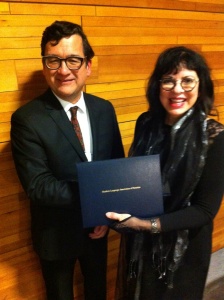 friends, poet and sound artist Tracie Morris, and fiction writer Tayari Jones came to the ceremony and hosted me on the town with champagne and a festive meal at the Four Seasons in Vancouver, British Columbia. Life is sweet! Thank you all.
friends, poet and sound artist Tracie Morris, and fiction writer Tayari Jones came to the ceremony and hosted me on the town with champagne and a festive meal at the Four Seasons in Vancouver, British Columbia. Life is sweet! Thank you all.

